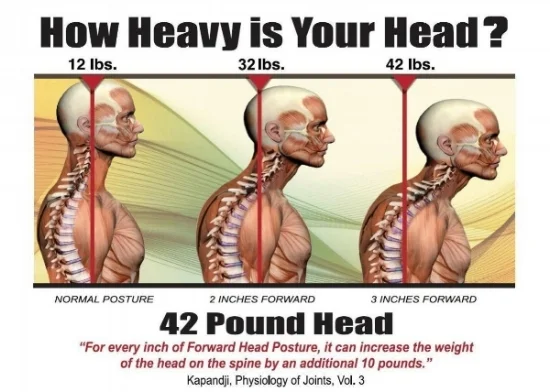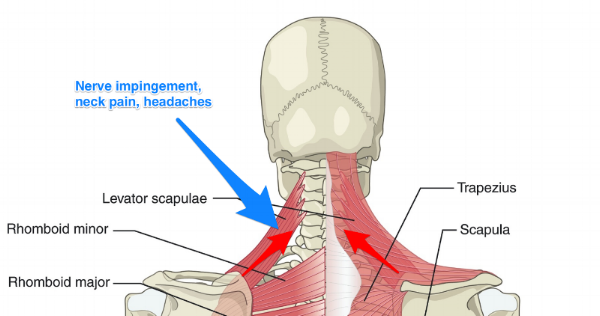In this post we will explore the effect that posture has on the spine. "Poor" posture can be a driving or aggravating factor in chronic neck pain and upper back pain. Achieving better posture is a goal that many people have, but it is important to define what we should be aiming for. My objective for this discussion is to provide guidelines to allow you move your body towards a more ideal posture. In order to do this, we must first examine the relevant anatomy and joint biomechanics.
The human head weighs on average about 8-12lbs. The ideal position for the head and neck, is one in which the opening of the ear is in line with the shoulder. This posture is optimal because it allow for a more even distribution of the weight of the head between the joints and the discs in the cervical spine (aka the neck). When we deviate from this position, we alter to a great degree the forces that are being placed on these structures. Moving the head forward in relation to the shoulder as little as one inch, will drastically increase the shear stresses on the cervical spine. When the head translates forward, the distribution of forces will change; this posture will place more strain on the discs in the lower aspect of the neck, and on the joints in the upper neck and upper back.
In addition to changing the mechanical forces at play in the neck, forward head carriage will make it more difficult for the stabilizing muscles in the area to do their job properly. In the ideal situation, the muscles in the front of the neck and the muscles in the back of the neck, work together to stabilize it. When the head is moved forward in relation to the shoulder, it makes it much harder for the muscles in the front of the neck to function properly. When the stability of these joints is compromised, the body attempts to compensate. It responds by demanding more from the muscles in the upper back. The muscles that are re (upper fibers of the trapezius and levator scapulae) insert into the upper aspect of the neck, and are employed in attempting to stabilize the neck in compensation. Excess tension in these muscles can lead to many issues. First and foremost, they are ineffective at stabilization. Additionally, due to how they insert into the bones of the neck, they can create torsional strain (torque) on the joints that will result in alignment issues over time. Joint malalignment will lead to an increased likelihood of injury, and speed joint cartilage degeneration. Additionally, misalignment in the upper cervical region (base of the skull) will predispose you to headache and migraine episodes.
To help visualize the biomechanics at play in the neck, we can turn to a weight training example; if you have a dumbbell (or even anything heavier than 5lbs within your reach)- try holding it close to your body for as long as you can. When you feel your muscles start to burn, put the weight down and allow yourself a few minutes for the muscles to recover. Pick up that same weight, and hold it at arms length away from your body. How much faster do you feel the muscles start to burn? Do you feel a difference in the stress being placed on the joints of your hand, wrist, elbow and shoulder? It is my hope that this example will help you understand why posture is so important, and how slight positional changes can increase the amount of strain on muscles, ligaments and joints.
Maintaining "good" posture allows the body to function properly from a biomechanical standpoint; a more neutral alignment will minimize stress on the joints, ligaments, tendons and muscles. In addition, it will also allow the stabilizing muscles to brace your spine properly, thereby helping you to avoid injury. The next post will discuss strategies that you can employ at home to try and move towards a more "ideal" posture. Stay tuned!


